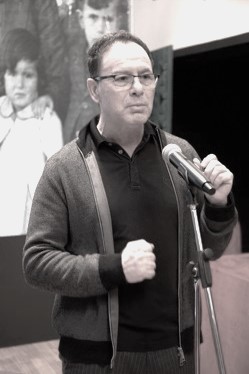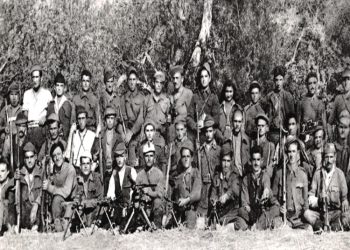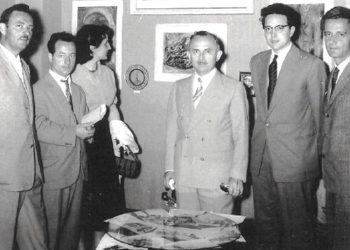Nga Uvil Zajmi
Memorie.al/It was my first time participating in such an event. A book was not being promoted, nor was there a commemoration of an anniversary. No journalists, no cameras, no television. Simply, in front of a mass of people, known and unknown among them, the family tree of the well-known family from Libohova, the SULO family, was being presented. A capillary network covered a whole wall, where, like in a process of nuclear disassembly, one name produced several names, and thus, name after name, it reached the names of numerous participants present in that large crowd of people, who happened to know each other. But most of them did not know each other even though they shared the same surname. When the family tree appeared on the wall, each person, with curiosity and immense zeal, began to navigate that “labyrinth of Minos,” where it was impossible to discern its end.
It was a challenging journey, constantly accompanied by questions, such as: “Look, Dr. Hajdar Sulo…my grandfather’s brother. Is there any of his grandchildren or great-grandchildren here?!” To the one who asked this question, someone tapped them on the back: “Here I am, I am Maliqi, his grandson, his son’s son.” Similar questions and scenes like this were repeated by the hundreds that evening. It began as a joyful gathering among the Sulos who knew each other, but “because of that tree” mapped out and displayed on the wall, it turned into a knowledge exercise, a question-and-answer session among Sulos who did not know each other.
Unknown names, forgotten names, names heard from family conversations decades ago, names accompanied by first figures from old photographs, names fixed in that capillary scheme built, also with living names, but with many more who had passed away. Inevitably, it was a night of remembrance and homage for those who no longer live, for their stories, which are inextricably linked to this place and the people of this place, as well as the meeting of the members of this large clan.
Presentation
The curiosity was great about how it was organized and what would be presented before the many attendees, invitees, relatives, etc. I have seen photos, schemes, layouts, even books we have read, published about the trunk or family tree of a well-known clan in Albania and beyond. But gathered like this, in a beautiful, modern hall, seeing relatives meeting and knowing each other, even though for the first time, despite having centuries-old kinship ties.
Emotions for everyone, then the presentation. It was also of a very special format: Everything was detailed clearly and beautifully when the family tree, the branched trunk, was projected on the large screen, accompanied by names, one after the other, from the ancestors of the clan to the heirs, up to the current members and their children. An extremely engaging scheme, in terms of content, the history it conveys, and precisely on that evening, I observed such a thing. Above all, for the colossal commitment from the authors, for the realization of which, a lot of time, knowledge, patience, collaboration, dedication, and responsibility are required.
What is a family tree?
For some time now, well-known families have been making efforts in the design, construction, and realization of such maps related to the representation of a family tree. It is an ancient tradition, but not widely applied during the years of socialism. In contrast, after the 1990s, there have been attempts, efforts, and greater opportunities to revive and apply such practices. This creates a very important tradition for recognition, connections, kinship, and also for culture and history, not only for prominent families but also for ordinary ones. In the field of genealogy, it is a kind of schematic representation of family relationships in a conventional structure, presented in the form of a tree.
Genealogical data can be represented in several formats, such as; a schematic reflection of ancestors. Family trees often present the oldest generations at the top and the younger generations at the bottom. An ancestry chart, which shows the ancestors of an individual, will resemble more a schematic representation in the form of a trunk or body of a tree, being wider at the top than at the bottom. In some ancestral graphics, an individual appears on the left, and his or her ancestors are on the right.
An ancestry table that describes all descendants of an individual will be narrower at the top. Family trees can have many branches. Someone might include all direct descendants of a single figure or all known ancestors of a living person. Another might include all members of a specific surname (e.g.; descendants of the male line).
Arben Sulo: “Here’s how we created the family tree of the clan”
With a profession as an electrical engineer and jurist, one of the contributors to that magnificent family map of the Libohova Sulo family, in this exclusive interview says: “It has been a systematic long-term commitment, utilizing all possible resources, both spoken and written, and to verify their accuracy. A research effort was made to secure, find materials, archive, store, and ensure their accuracy.” For more about this, etc., he informs us in the following interview.
Mr. Sulo, what information did you have from the histories and trunks of the major families?
The trunks of major families have served as a point of reference and encouragement, such as those of the families; Kastrioti, Muzaka, Arianiti, Balsha, Zerebishi, Gjin Bue Shpata, Topiaj, Vlora, Toptani, Vrioni, Biçaku, Vërlaci, Merlika, Serreqi, Markagjoni, Mirakaj, Blloshmi, Kazazi, etc. Many of these families are interlinked through marriage ties among themselves, giving a broader span to the family tree over the years and centuries.
This is based on facts from written works, as in the case of the family of Gjon Muzaka, which we find documented in the Italian language. Archived materials from the 16th century are preserved even to this day. The sensitivity to build the country’s past, starting from the history of specific families, has been quite widespread, especially in cities, among urban families that have played a role in the history of the country throughout all times.
Do you think these were some of the reasons that drove intellectuals and the patriotic elite of the country to seek historical roots, starting from their families, eventually leading to the history of the Albanian people and nation?
It is more than true; the exploration of the family trunk over many generations, in our case, we have reached seven generations, and the lives and activities of our ancestors are inextricably linked to the traditions and history of our country. Many individuals from this trunk, at different documented times, have made significant contributions to the life of this country, with dedication and often great sacrifices.
These contributions have spanned both economic engagement and involvement in patriotic activities, for which some even sacrificed their lives or faced imprisonment, internment, persecution, etc., at all times. I reiterate, all of these are documented, but it may not be appropriate in this short article to mention them by name, surname, and accuracy, as it would be a long list.
This is a very concrete tradition also for Libohova, and it has been the case for families in other cities and even rural areas. Do you see this as an effort to build the genealogical trees of well-known families, contributing significantly to the history of Albania?
Yes, Libohova is a distinguished place for its prominent families, which have had educated individuals throughout all times, intellectuals and patriots. One among them has been the Sulo family, previously known as Libohova, until the 1920s, when the population registration was conducted, and at that time the government required that surnames associated with villages or regions be replaced with surnames of origin.
Only from our clan, since the 1800s, up to where we have been able to trace our ancestry, many have graduated abroad, in well-known universities and academies, prominent jurists such as Ferhat Sulo, Halim Sulo, Dervish Sulo, Hysen Sulo, Mahmut Sulo, prominent doctors like Hajdar Sulo, Qeramudin Sulo, Hysamudin Sulo, Reuf Sulo, or military figures like Hiqmet Sulo, Fiqiri Sulo, and many others. Here, I have mentioned only those I know well, being close in the family line.
Do you see this as an effort to fulfill a promise from your ancestors?
I believe so, and in this context, we have had an encouragement, a message, a legacy from our ancestors, proud of their heritage, to not forget our roots. They are the ones who have nurtured this feeling in us, to take an interest in the land, family, ancestors, and descendants. There is no Libohova resident who, regardless of where they are, does not visit their hometown, who does not maintain friendships and kinship ties with their relatives, regardless of time and distance, which have been influenced by transfers and movements over different periods; this relationship has functioned. Wherever we were born and raised, when asked, we all proudly say: we are from Libohova.
A history stretched over centuries and several generations?
In this spirit, we also realized this family event, the presentation of the genealogical tree, a result of years of efforts to clarify the trunk, reaching back to a time that, of course, is not easy, starting from the year 1800 and onward, with branches spread out, not only in Libohova but throughout Albania, Tirana, Berat, Fier, Vlorë, Shkodër, etc. Meanwhile, from the two brothers of the 1800s, we reached hundreds and hundreds of names, up to the present day, keeping in mind that we tried to make it as comprehensive as possible, including the ancestors of the Sulo clan, as well as its branches in families with different surnames, due to marriages of the daughters.
Mr. Sulo, as you mentioned earlier, the realization of the tree and the event of the Sulo clan and its branches is a significant commitment, and of course in these lines, you can’t mention everything in detail, but if you could briefly tell us how you specifically accomplished it?
Well, for many years, since the 1990s, there have been several attempts and activities aimed at shedding light on the lives and activities of our ancestors, speaking from the perspective of us as the descendants of Dr. Hajdar Sulo, my great-grandfather, a part that I know better, outlined in meetings together, books about him, decorations for his activity, and continued with his descendants.
Additionally, our parents contributed with their memories and documents that they had, including the realization of the book “100 FAMILJE SHQIPTARE,” by authors Donika and Skënder Anxhaku, in which the authors wanted to dedicate a chapter to the Sulo family. There are also two books that shed light on the Sulo family, such as “JURISTËT LIBOHOVITË” and the other “MJEKËT, DENTISTËT, VETERINERËT, FARMACISTËT LIBOHOVITË” by Professor Uran Asllani, where many among them are from our clan.
A public presentation, with many attendees, also for several reasons…?
In recent years, we, the younger generation, have made efforts to gather and get to know the parts we were not familiar with, and we have organized several meetings among us. We have also met on occasions of joy and sorrow, part of life. From these gatherings, meeting people we had not met physically before, it was evident that almost everyone was enthusiastic about this initiative, and we realized how many common characteristics we had and our desire to continue this tradition, which to this day, we frequently engage with each other.
You mentioned that you chose a somewhat special date; for what reason?
The culmination of these efforts to recognize our clan was finalized with the realization of the tree and the event in honor of our clan. The date chosen was February 24, which coincided with the 85th anniversary of the birth of Astrit Sulo, who has unfortunately passed away three years ago, and who was among the promoters of maintaining family ties, which he entrusted to his sons, Genti and Elvis, to preserve and carry forward.
In realizing this event and the genealogical tree, they had a major contribution in organizing and executing it, a realization that was certainly not easy, starting from deepening our knowledge with the stories of the elders, consulting written materials, books, archives, etc., as well as the graphical realization of the genealogical tree and the logistical part. Moreover, that date, conventionally and collectively, we have also considered a date to dedicate to our clan and its continuation.
From this event, as you described above, what goals were achieved, what are your impressions afterward, reflections, aspirations, etc.?
It’s a valid question, as it was described up to that point as something beautiful that made us feel good, etc. However, what is more important is the recognition of roots, heritage, common characteristics, getting to know one another, and the possibility and motivation for our children and grandchildren to carry this forward in the future. It is very important to know your roots and to have an identity; this further strengthens families, which are the cells of society, and consequently serves the country.
A slightly provocative question: when you mention that there are hundreds and hundreds of people in that tree, as you mentioned earlier, do you find common characteristics? Given that there is also diversity within a family, what common characteristics have you noticed among yourselves?
In that tree, there is indeed a very large and diverse group of people with different educational backgrounds, various occupations, and different political beliefs and commitments, often even antagonistic, but if I were to express it mathematically, the resultant of the clan’s commonality is that the majority of them have been characterized by patriotism across all times and integrity in their work and commitments based on personal beliefs, not necessarily the best rights and benefits, but guided by the principles mentioned above.
Mr. Arben, in conclusion of the interview, how would you summarize everything mentioned above?
As a conclusion, almost all of us who participated in that event felt not only proud but also more united, more aware that even among clan members, who might be antagonistic in some directions, there were many more things that united us than divided us—good things, I mean, not in terms of interests. After that meeting, we felt even more motivated to continue this tradition in the future, to deepen, improve, and enrich this knowledge, leaving it as a legacy to our descendants./Memorie.al
















